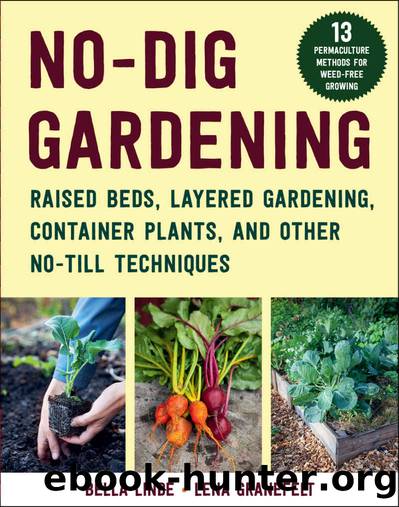No-Dig Gardening by Bella Linde

Author:Bella Linde
Language: eng
Format: mobi, epub
ISBN: 9781510770478
Publisher: Skyhorse Publishing
Published: 2022-04-15T00:00:00+00:00
LUSCIOUS LEACHATE
The liquid collected at the bottom of the Bokashi bucket contains nutrition and leftover good microorganisms. You can tap some excellent fertilizing liquid from a Bokashi bucket fitted with a spigot. The liquid is very potent and needs to be diluted with water at a ratio of 1:100. Leachate often smells bad but the result makes it all worth it.
Bokashi is usually buried in the ground, but for No-Dig gardening the material can be mixed with soil in a closed but ventilated bucket, box, barrel, or pallet collar. It becomes a kind of soil factory in which the bokashi compost takes on soil form, which can later be spread across the gardening bed. There is less risk of vermin interfering with this closed soil factory.
The bokashi compost can also be layered in the gardening bed. It is placed directly on the bed and is covered by soil, leaves, straw, and other organic materials. Itâs wise to place a compost grid on top to stop curious animals from having a closer look. The conversion to soil happens in a few weeks during summer but the colder it gets the longer it takes. Freezing weather doesnât harm the process. Warmer weather will restart it.
Container: There are specially designed containers for sale that come with a sieve and a spigot for recuperating the precious leachate. However, it is just as easy to use common household buckets if the bottom is layered with biochar, egg cartons, or newspapers to soak up the leachate, avoiding bad odors. It is important to have a tight-fitting lid on your bucket because the method relies on an oxygen-free atmosphere to ferment the waste.
Accessories: Bokashi bran, commonly wheat bran that has been grafted with a variety of efficient microorganisms (EM), or liquid bokashi spray, can be found in plant nurseries or online. A closed but ventilated container, for example, a garbage can with a lid slightly ajar, is also needed to use as a soil factory.
Placement: Under the sink if indoors. It can also be placed outdoors.
How to: Spread a few tablespoons of bokashi bran on the bottom of the container, or rinse it with a dose of bokashi spray. If using a bucket, place a layer of newspaper on the bottom. Add some crushed grill charcoal or biochar for even better results.
Add the waste, preferably broken up into smaller pieces. Sprinkle over a few tablespoons of bokashi bran per quart (1 liter) of waste, or one or two squirts of bokashi spray. Press the material down hard with a compactor or potato masher. The method works on the principle the bucket maintains an oxygen-free atmosphere; so donât lift the lid unnecessarily. Collect food waste in a smaller container with a lid to prevent flies from depositing their eggs in the waste. Move the waste to the bokashi container once a day and replace the lid carefully. Once itâs full, the container needs to rest for two weeks at room temperature. This is when the fermenting process happens. After itâs fermented, the material is moved to the larger soil factory container.
Download
This site does not store any files on its server. We only index and link to content provided by other sites. Please contact the content providers to delete copyright contents if any and email us, we'll remove relevant links or contents immediately.
Craft Beer for the Homebrewer by Michael Agnew(18200)
Marijuana Grower's Handbook by Ed Rosenthal(3647)
Barkskins by Annie Proulx(3336)
Project Animal Farm: An Accidental Journey into the Secret World of Farming and the Truth About Our Food by Sonia Faruqi(3191)
The Plant Messiah by Carlos Magdalena(2900)
Red Famine: Stalin's War on Ukraine by Anne Applebaum(2894)
0041152001443424520 .pdf by Unknown(2819)
Organic Mushroom Farming and Mycoremediation by Tradd Cotter(2661)
In the Woods by Tana French(2562)
Beer is proof God loves us by Charles W. Bamforth(2419)
7-14 Days by Noah Waters(2389)
Borders by unknow(2281)
Reservoir 13 by Jon McGregor(2267)
Meathooked by Marta Zaraska(2239)
The Art of Making Gelato by Morgan Morano(2234)
Between Two Fires by Christopher Buehlman(2225)
Birds, Beasts and Relatives by Gerald Durrell(2198)
The 7 Habits of Highly Effective People: Powerful Lessons in Personal Change (25th Anniversary Edition) by Covey Stephen R(2170)
The Lean Farm Guide to Growing Vegetables: More In-Depth Lean Techniques for Efficient Organic Production by Ben Hartman(2107)
